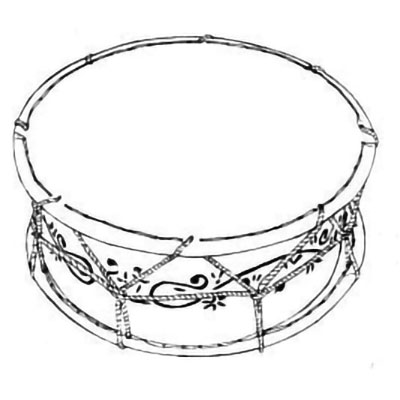yuangu overview
 The round drum (pinyin: Yuán gǔ) is a mixture of the Manchu and the Korean people. In Manchu, it is called Tongken, also known as carrying drum. The Koreans are also called flat drums and folk drums. Popular in Liaoning, Jilin, Heilongjiang and other provinces, especially in Yanbian Korean Autonomous Prefecture in Jilin Province. It was originally an accompaniment instrument used in Manchu shamanistic sacrificial activities. "Manchu sacrifice to God and Heaven Ceremony" has: "The drums are different from hand drums and frame drums, all of which are played by the master's family. The slow one is based on the sound of the Sama (Manchu) drum." The history is relatively long.
The round drum (pinyin: Yuán gǔ) is a mixture of the Manchu and the Korean people. In Manchu, it is called Tongken, also known as carrying drum. The Koreans are also called flat drums and folk drums. Popular in Liaoning, Jilin, Heilongjiang and other provinces, especially in Yanbian Korean Autonomous Prefecture in Jilin Province. It was originally an accompaniment instrument used in Manchu shamanistic sacrificial activities. "Manchu sacrifice to God and Heaven Ceremony" has: "The drums are different from hand drums and frame drums, all of which are played by the master's family. The slow one is based on the sound of the Sama (Manchu) drum." The history is relatively long.The Manchu round drum is shaped like a short barrel. The drum frame is made of wood. The two ends are covered with horse skin or donkey skin. There are equidistant holes on the edge of the leather surface. In the middle, tighten the leather surface to fix it on both ends of the drum frame, and the drum head tension is adjustable. The drum surface is 30 cm in diameter and the drum frame is 25 cm high.
The round drum of the Korean nationality is flat and round in shape, so it is called the flat drum. The drum frame is made of wood, covered with cowhide or sheepskin on both sides, first sew the leather surface on the circular rattan circle, insert the rope into the two rattan circles, tighten the rope to make the drum surface taut at both ends, and wrap the remaining rope. In the middle of the drum frame, the tension of the drum head can be tightened and the pitch can be adjusted. The diameter of the drum surface is 30 cm to 45 cm, and the height of the drum frame is 15 cm to 20 cm.
The Korean round drum and drum frame collected by the Chinese Musical Instrument Museum of the Music Research Institute of the Chinese Academy of Arts in Beijing are made by baking and bending multi-layer boards. The diameter of the drum frame is 37 cm, the height of the drum frame is 17 cm, and the wall thickness of the frame is 1 cm. The end is covered with cowhide, the leather surface is sewn on two rattan rings with a diameter of 42 cm, and the red thread is passed through the rattan rings to tighten the drum skin. The drum body is painted with red lacquer, and the production process is fine. This drum has been included in the large picture book "Chinese Musical Instruments Guide".
When playing, the Manchu folk usually place the drum between the knees and play it with fingers or palms. When a shaman is performing, the drum is carried on the shoulders or placed on a wooden frame to play; Korean folk usually wrap red cloth belts around the drum frame, hang the drum vertically on the chest, and slap the left drum with the left hand. On the face, the right hand holds the wooden hoist to strike the right drum face or drum rim. The pronunciation is soft and loud, with no fixed pitch. The playing style is similar to the stick drum, and the rhythm changes more. When the performer is excited, he flies the drum up and down, with a humorous and lively expression. You can also place the round drum on the back of the left foot, control the drumming part by extending and flexing the left foot, supporting the drum with the left hand, and slapping or percussion with the right hand. Often used in folk instrumental ensembles or singing and dancing accompaniment. The round drum of the Korean nationality is often played in ensemble with the stick drum and the flute, and plays a leading role in the folk orchestra. In addition to being used for performance, it is also a prop for folk dance. The round drum has become an inseparable rhythmic instrument for festivals, holidays and festive occasions.
- Pinyin:Yuán gǔ
- popular area:Liaoning, Jilin, Heilongjiang
- alias:lift the drum
- Drum diameter:30cm~45cm
overview of other similar instruments
- sanyanxiao overview
- Daguangxian overview
- Leiqin overview
- hahao overview
- yandundagu overview
- Han Xiaozheng overview
- Fang Xiang overview
- guanzi overview
- zhuqin (Dao Qin) overview
- zhuiqin overview
- bangzi overview
- three-stringed piano overview
- Gehu overview
- xiao overview
- xiaokonghou overview
- Konghou overview
- Sheng overview
- suona overview
- hulusi overview
- gushao overview
 渝公网安备 50010702504639号
渝公网安备 50010702504639号